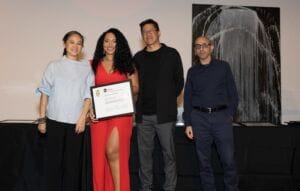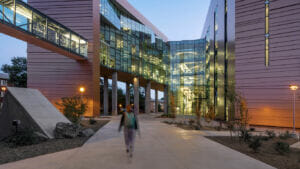The Yatkowski family uses every inch of their DC Ranch home — all 13,128 square feet of livable space.
Paul and Kari Yatkowski’s Southwest-Mediterranean-style two-level at DC Ranch in north Scottsdale includes five bedrooms, nine bathrooms, a five-car garage and a detached 602-square-foot casita with another bedroom and bath, which the couple generously opens for friends and family. An acre-plus wash-delineated lot, blending lush high desert and xeriscaping, privatizes them from neighbors and the golf course.
“They loved the location on a quiet cul-de-sac with great views of the mountains and city lights,” says Ron Steege, co-principal, with Tim Larson, of La Casa Builders, Scottsdale.
To complete the team, the Yatkowski’s selected Scottsdale architect David Dick, who had designed their former Ahwatukee home, and, for the interior design, Holly Ogden, ASID, of Wiseman and Gale Interiors, Scottsdale. Design and building required two years, and the family moved in July 2009.
West by Midwest
“We bought the lot and built here because we felt that this was as close to how we grew up,” says Kari, a native of Spearfish, S.D., famous for its gold-rush past, mining present and proximity to Mount Rushmore National Park. Similarly, Paul grew up in Winnipeg, Canada, before coming to the United States to play football for the University of Tennessee. “As you would expect, that creates some family rivalry,” says Kari, an Arizona State University graduate.
“We wanted the amenities of a master-planned community and the fabric of a traditional community,” she adds. “We wanted a home where the children can ride their bikes down the street and go to school with the same children they play football with.”
Married 10 years, they have three boys: twins and a high schooler from Kari’s first marriage. Also residing at the home are a half dozen dogs and cats, living the DC Ranch lifestyle with apparent satisfaction, enjoying designated feeding areas and siesta nooks: “I’d have a 100 animals if I could,” says Kari, who works closely with nonprofits supporting families with children and animal causes throughout the Valley.
The DC Ranch community provides them with hiking trails into the McDowell Mountain Preserve, neighborhood parks and amenities such as the Desert Center, an 8,000-square-foot facility on nine acres, including fitness rooms, heated pool, tennis, volleyball and basketball; and the Homestead Community Center, with a 7,000-square-foot facility, including the innovative Homestead Playhouse community theater. Nearby are the shops and restaurants of DC Ranch Marketplace.
Every year when the boys are off from school, they spend time in a second home in Colorado, but for most of this summer, Kari will be vernal social director, hoping to schedule activities at the house, the DC Ranch community centers and other Scottsdale-area activities.
“This will be our first summer here,” she notes, with a sigh. “What do you do with three boys for four summer months?” she continues with a big smile, looking out toward their backyard, which the La Casa team has fitted with a large pool, including an electric cover for safety and low maintenance, a heated pool bath/spa and a trampoline area. “Well, they do like to swim.”
A living home
Fortunately, how the Yatkowski’s designed their home provides many activity options beyond swimming and trampolining in the summer as well as in cooler times of the year. “We didn’t go into it to design our home according to a set theme or style,” says Kari, who works out of the home for Corporate Citizen, her consulting company that provides corporate-giving strategies to clients who want to align their businesses with nonprofits.
From her office, connected to Paul’s through a medial hallway, she also coordinates Haven Charitable Foundation, a family foundation established to assist nonprofits make wise and lasting changes.
“It was so much more important for us to program the home for our lifestyle, for the way we live every day,” she says. “I’ve been in some spectacular homes, but sometimes I don’t know how people can live in them with kids and dogs; they’re so fussy. For Paul and me and the kids, a home is for living.”
Modularity and scale are essential design elements. Although the home is large, it’s nimble, flexible, up to the challenge of a three-child (plus friends) home. “We didn’t want all high-vaulted ceilings, with a sense of immensity, so we decided early on to bring the home down to the Arizona lifestyle we wanted to enjoy,” she says.
“When it’s our little family, it feels it’s just our little family and nothing more, but when you have a big group and entertaining, we can activate spaces to make our home work for us and them,” she adds. “Everything seems connected here, rather than having wings spread out. It’s compartmentalized but open, too.
“Paul and I both come from Midwest environments, where all of the rooms are small, so we tried to blend the large overall imprint of the home with this concept,” explains Kari, who traveled to Arizona with her car and clothes two decades ago to attend a “warm-weather school.” From ASU, she graduated with a degree in supply chain management and followed with a successful corporate career until she had the twins.
For example, the foyer seamlessly leads to the great room, with this large space opening through collapsing walls to the outdoor hearth room, including a gas barbecue, a fireplace built into a support wall viewable from the foyer and seasonal heaters and misters. The pool area is conveniently off to the right.
“This is what living in Arizona is all about, and how La Casa builds homes,” says Steege, who was also born and educated in the Midwest and who chose to move to the Valley with his wife, Jennifer, because of the many attractions of the desert. “We always enjoy the opportunity to create a true indoor/outdoor lifestyle experience, and this home exemplifies that.”
Left of the elegantly finished foyer/great room is an expansive French-style kitchen, which opens through archways into a breakfast room on one side and, on the other, the formal dining room with an adjacent room built for Kari’s cherished dish collection. “This immediate kitchen area is the heart of where we live and is very comfortable,” she adds. She also regularly uses a walk-in cooler and walk-in pantry. “You can certainly live without a walk-in cooler, but it’s been so helpful with the family,” she says.
“Paul and I don’t formally entertain a lot, but we entertain informally often, so this area sets the tone very well for our casual lifestyle,” she adds. It’s often the area that gets used, too, by the children: “We’ve become the Kool-Aid stop for the neighborhood,” she explains, with a laugh. “So, after the games, after school, this is a popular place.”
In a similar spirit of connectedness, the boys’ playroom/TV room is off this central everyday locus; here, there are also areas for them to read and study. Just behind this are their rooms, to which Kari has allowed them to liberally place ASU Sun Devil and UT Volunteers peel-away decals on the walls — “They’re called Fatheads,” she says — which Paul paternally tolerates, with his University of Tennessee connection.
Upstairs is the older son’s home — more like a hotel suite, including a bedroom with a window niche daybed for buddies and a sitting room. On this level is also an enormous game room featuring a view deck, billiards table and multiple screens for watching Paul’s favorite teams simultaneously.
While Paul’s doing that on the second floor with friends, Kari can be showing a group of 15-year-olds a movie downstairs in the home theater and entertaining eight-year-olds with an afternoon Kool-Aid break at the kitchen island.
“We use every square inch,” she says.
A home that finishes well
Utilitarian in many ways — Kari: “It’s like a tank or a well-oiled machine” — the home also includes superlative materials, finishes and touches. Flooring in the living, master, dining, gallery, foyer and formal powder is walnut, and the two stairways to the second floor and its game room are reclaimed oak.
Throughout are French limestone fireplaces, hand-forged metal doors for the wine room and dish room, a hand-carved entry door and a handmade zinc bar top for the game room and details such as a hand-made leopard pattern carpet, by Stark, in the master bedroom closet.
She particularly enjoys the influences and textures of Provence and countryside France, and they appear throughout in artwork (a hotel guest registry along a corridor, for example), wallpapers, a powder room (“something girly for me”) and various niches, such as the daybed in the master bedroom bath, of which Paul once asked, “Why do we need this? What is it for?” “Because it’s pretty,” she told him.
Pretty, too, and eco-friendly are the reclaimed Douglas fir beams from old sawmills on the great room ceiling. Tim Larson traveled to Oregon to hand select them — a trademark service and resource of La Casa Builders exclusive to its homeowners.
“We first asked, ‘Should we patch the old bolt and nail holes?’ But we thought they’re not so rustic that you feel there are cobwebs,” she says. “And now, looking at them every day, they’re perfect — just the way they are.”
Photos of the Yatkowskis’ home:
 |
 |
 |
 |
 |
 |
 |
 |
 |
 |



